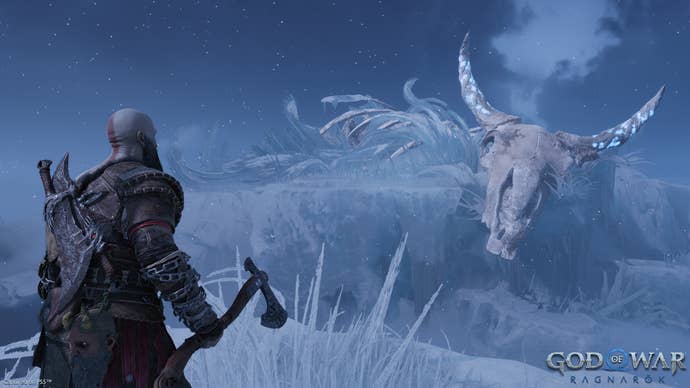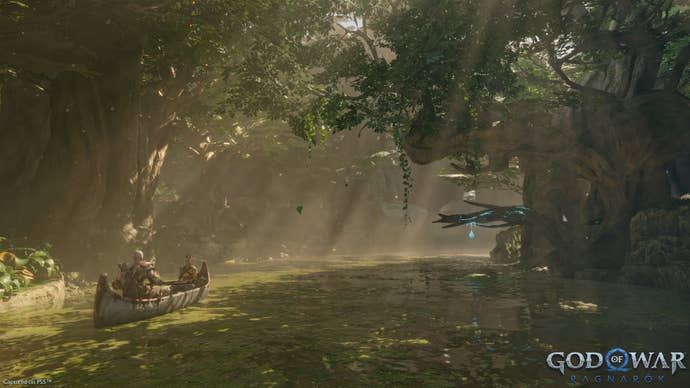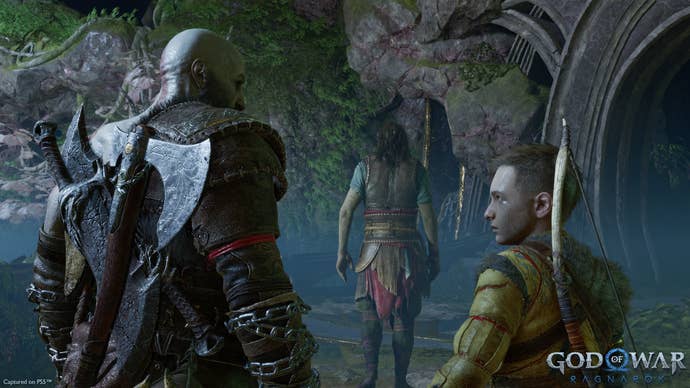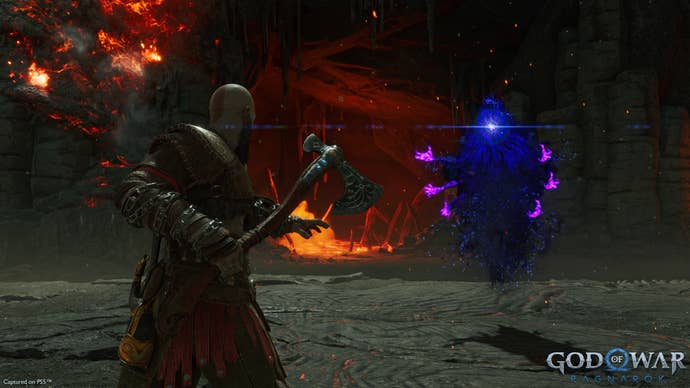God of War Ragnarok review: Unmatched spectacle action that's determined to say the quiet part loud
What did we think of Kratos and Atreus' latest adventure? Find out in our God of War Ragnarok review!
It says everything you need to know about God of War Ragnarok that you can go from listening to the captivating tales of Norse mythology, as told by your best mates as you float gently past dense riverbanks of lush jungle and along placid lakes surrounded by snow-capped mountains, to squishing giant flying eyeballs with your bare hands in the space of about 90 seconds.
Neither feel out of place or jarring, but the flying eyeballs probably disagree.
Although it starts out remarkably similar to the 2018 God of War both mechanically and graphically, God of War Ragnarok gradually builds into a meaningful evolution for the series, expanding the scope of gameplay both stealthily and overtly, while delivering a tense and twisty story that bends legend around its characters in exciting and endlessly interesting ways.
God of War Ragnarok takes place across all nine realms of Norse cosmology, as Odin – king and all-father of the Aesir gods – moves literal heaven and earth to try and avert the doomsday that’s prophesied to bring about his destruction. At the end of the last game, Kratos and Atreus learned their unwitting part in the prophecy, and God of War Ragnarok deals with the ramifications of this new knowledge, and the fallout of the events that led up to acquiring it.

It’s a very direct sequel and, maybe because of a few years of distance and watching beautified PC port footage in between, starting Ragnarok almost felt like booting up the last game and playing on right from where it ended.
In the Sony first-party pantheon, despite the upgrade in hardware, Ragnarok feels a lot more like the jump between Uncharted 2 and Uncharted 3, rather than the more recent example of The Last of Us Parts 1 and 2. This obviously makes sense given both the development time between the rebooted God of War and Ragnarok (which would have been just a couple of years without a lengthy delay), and its cross-generation availability as well.
It looks and feels great, with detailed environments and distant landscapes in every realm, but there aren’t any huge technical or graphical feats that leap off the screen immediately. And that could make for a disappointing first impression if you’re expecting something that’s going to make your PS5 whur like a jet engine, like it does your PS4.
That’s not to say that God of War Ragnarok is a complete retread, or does nothing to take things forward. What’s familiar swells over the course of the game – whether it’s combat styles, companion abilities, traversal or puzzle-solving – to the point where you realise later on in the whole experience just how much is different and new.
The first few hours, then, feel quite close to what you’ve played already, and if Sony Santa Monica tried to introduce a lot of this more quickly, just for the sake of difference, it might have felt overwhelming or disparate, so ultimately it’s the right choice for the game as a whole. Even if, sometimes, you're encouraging it all to speed up a bit.

You’ve got a lot of time to explore the mechanical nuances once they start to show up, though. Where the console-showpiece spectacle action genre used to be a linear 6-hour firework, God of War Ragnarok is as chunky as Kratos’ own bicep, taking me just over 40 hours to complete the main story (with about 75% of side stories, collectibles, and extra tidbits thrown in, too) on the regular difficulty.
At the end of a main story branch, you almost always have the option to break off into a relatively compact – but very dense – open exploration area filled with environmental puzzles, mini-bosses, and fetch quests. Diving into these spaces is heavily encouraged not just for the world and character-building exploits(the main “Favours” in each area are generally good), but because they offer a lot of the best stuff and upgrades, making them pretty vital if you want to make smooth progress in the next chapter.
These areas aren’t disposable, either. More activities appear pretty constantly as the world state changes throughout the main quest and even after the credits roll, continually giving you an incentive to keep the realm-hopping family road trip rolling. But the persistent diversions can also be a bit distracting, both in the exploration areas and along the main path.
There’s something hidden around nearly every corner, and sniffing it out can take you out of the moment a bit. If you’re a magpie, like me, you'll be thinking more about the collectible you need to smash in the corner while a cutscene’s playing than what’s actually going on. Those with short attention spans, be warned.

But if you know that you can’t really miss anything and you can always go back and get things that you do miss – which you know now, because I’m telling you – hopefully most people can push through that completionist itch.
I wrote in my early impressions preview that the beginning of God of War Ragnarok’s story had me a little worried because it laid on the emotional moves thicker than the hide of the world snake, Jormungandr. Right from pressing “New Game”, it’s all heavy hearts, long sighs, and sombre silences that threaten to tip into becoming maudlin – and at this point, that feels like a Sony studio party trick.
However, character motivations quickly reestablish themselves to make everything feel more earned – and from there, Ragnarok never loses its great moments. An early standoff between the game’s main players is crackling with intense atmosphere and menace, and the unexpected and intricate characterisations of many of Ragnarok’s antagonists are almost as revolutionary as the renewed depth to Kratos’ character in the 2018 God of War.
These moments come more frequently, more intensely, as the game edges towards its climax. Then, from the summation of the last full realm arc until the blockbuster finale, it’s gigantic, cataclysmic set-piece after set-piece – wielding the full weight of everything that’s built up to this point to grip you as aggressively and wrathfully as the characters battling on-screen.

It’s not just about the engrossingly spectacular, but the quieter parts, too. Drawing on themes of responsibility, loss and, chiefly, the uncertainty over changing stages of life gives us an emotional impetus and makes the edge of the action cut much more keenly. Whether the story mulls on growing up, fatherhood, or death, it does it reflectively and knowingly. And it always makes you care.
The only quibble I have with all of this is where characters have a tendency to basically state the insinuations of a scene; saying the quiet part out loud when it was already well-earned and clear from the context and performances. I wouldn’t say that it undercuts anything too important, because when the real emotional moments touch down they land like a swan on water.
But it does feel like there was some undue worry that people wouldn’t “get it”. This is particularly felt at the end of the main Favours in each area which often finish with a conversation which comes off a bit like a plenary at the end of a school lesson or the coda at the end of a sitcom – “so what did we all learn today?”
But that's all overshadowed by the action, anyway. Once you get used to the touch-tight camera angle(which can make it feel like you’re getting brained by things outside of your peripheral vision before you master the audio and visual cues), the arsenal of weapons, combos, and abilities at your disposal feels incredibly flexible – with supplementary items to modify almost every option available to you.
.png?width=690&quality=70&format=jpg&auto=webp)
So much information is communicated to you so naturally by subtle things – the clunk of an inert attack on an armoured enemy, or the slight twinkle of a fully-charged swing – that finding your own style within the skillset is instinctive. And that’s without the jarring stops and slowdowns that give knuckle-cracking impact to every hit and have you throwing yourself into each shot, like a football manager kicking every ball for their team on the sidelines.
You get the biggest sense of this in the many, passionately fierce boss fights that punctuate the game. They do a great job of incorporating unique mechanics without coming off as cheap or overly simple. And, really, these boss fights are emblematic of what makes God of War Ragnarok great: they’re hugely successful meldings of an involving story and brutal action that not only produce an eye-popping, absorbing spectacle, but an impassioned investment in the outcome as well.
God of War Ragnarok launches on November 9, 2022. Reviewed on PS5, code provided by publisher.










